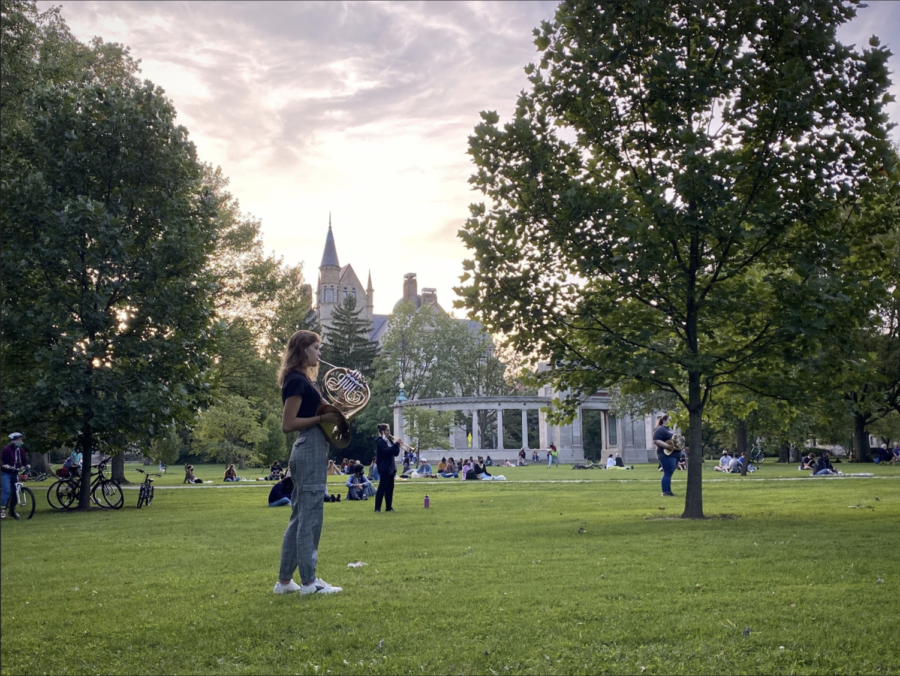Live Music Returns to Oberlin
This past fall’s performance of “Sila, Breath of the World” was the Conservatory’s first foray into organizing outdoor concerts under ObieSafe. After more than a year of hybrid schedules and virtual recitals, the Conservatory has now announced plans to begin regular live outdoor programming.
For Conservatory fourth- and fifth-years, strict restrictions on in-person gatherings led them to believe they might not have another chance to perform live at Oberlin. But thanks to improving weather and robust nation- and statewide vaccination rollouts, the Conservatory has announced plans to begin live outdoor performances.
In response to easing restrictions, a flood of excited Conservatory students and faculty quickly arranged new live shows or reworked previously scheduled virtual performances for in-person audiences.
“In the month of April alone, there’s a TIMARA recital in Tappan, choir concerts in Wilder Bowl, and jazz performances in the Tappan Bandstand,” Senior Associate Dean of Academic Affairs Peter Swendsen of the Conservatory wrote in an email to the Review.
The Student Union, the Black Musicians’ Guild, and the Conservatory Council of Students put together “Black Renaissance: A Celebration of Black Artistry” in Wilder Bowl on March 29, offering the first of what will hopefully be many new live performance opportunities for students. Double-degree fifth-year Max Addae was among the talented group of performers that day.
“I was fortunate enough to get to perform in the ‘Black Renaissance’ event a couple weeks ago — which was one of the first live performances I’ve done with an in-person audience in over a year — so that was such a great experience,” Addae said.
Prior to “Black Renaissance,” the pandemic desolated Oberlin’s traditionally thriving music scene. This didn’t just impact Conservatory students’ ability to perform — there were also fewer opportunities to be inspired by other musicians.
“As a composer and artist, I gain so much creative inspiration from the Oberlin artistic scene,” Addae said. “The countless amount of student recitals, dance showcases, theater performances, guest artist concerts, etc. that Oberlin normally would have are things that have really driven my artistic journey here. So trying to write music now without that constant exchange of artistic energy certainly hasn’t been easy for me.”
According to the Office of the Dean of the Conservatory’s COVID-19 and 2020–21 Academic Year Frequently Asked Questions page, the guidelines for outdoor performances correspond to all ObieSafe guidelines put in place for similar outdoor activities. Masks must be worn by all individuals, and individuals must remain at least six feet apart from one another. However, there is no restriction on the number of musicians who can perform in these outdoor performances.
Swendsen and Associate Dean for Operations Michael Straus have been working tirelessly along with faculty, staff, and students to put together safe outdoor performances.
“In conjunction with Oberlin’s ObieSafe team, the Conservatory has developed specific guidelines for outdoor performance activities taking place on campus,” Straus wrote in an email to the Review. “These guidelines cover everything from masking, distancing, and capacity questions to the approved venues on campus.”
While all are thrilled for the opportunity to perform live on campus again, Conservatory students will continue to exercise the resilience, flexibility, and new skills they have developed over the past year.
“[The pandemic] has also challenged me to rethink what performance and artistic collaboration can look like,” Addae said. “It’s forced us as musicians and artists to think outside the box, to adapt our craft in new ways, and develop tons of new skill sets. It opens up a completely new world of possibilities, which I find really exciting.”
The Conservatory has a full list of upcoming performance opportunities for students to support their peers, both virtually and in-person, on its website.











